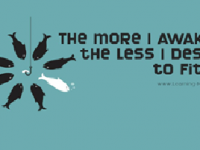I spend a great deal of my time researching and trying to understand why people do what they do and especially why I do the things I do. I am fascinated by everything about the human race, God, the spiritual realms and nature. Below is something I came across from: http://www.spiritualresearchfoundation.org/
- Introduction
As mentioned in an earlier article destiny accounts for 65% of our lives. This is the part of our lives that is not under our control. Due to the give-and-take account that we create with the individuals around us, we also increase the amount of account that we have to settle in either this or other lifetimes.
Unknown to our conscious mind, we are more often than not acting or thinking because of deep-rooted impressions in our subconscious mind. Destiny and the give-and-take account are reflected in the way we live our lives and heavily influence the choices that we make. So what is the mechanism of action of the give-and-take account? We have provided an example below that will help to clarify how the give-and-take account influences our choices.
However first we must understand the various aspects of our being that are necessary to perform any action or carry out any decision. Some of these aspects are unknown to modern sciences.
- Aspects of a human being that are required to carry out a decision
The diagram below is a representation of the aspects of a human being involved during the decision making process. Some of these aspects are not physical and cannot be seen by the naked eye. The circle represents the subtle or causal body (kāraṇdēha) of a person, which includes the mind and intellect. By mind we mean the feelings, emotions and desires and by intellect we mean our decision making and reasoning ability. Both the mind and the intellect cannot be seen.

As you can see from the above picture, the following five centres store memories of different types in the subconscious mind:
2.1. Identification and interpretation centre
This centre identifies and interprets the nature of an impulse.
2.2. Give-and-take account centre
This centre maintains accounts of all types of give-and-take with others and also tries to settle the account. For example, if Mr. X physically assaults a person, then the give-and-take account centre of that person remembers it and prompts him to try and assault Mr. X whenever he has an opportunity to do so, or he tries to create that opportunity or gives proportionate sorrow/unhappiness to Mr. X.
2.3. Instinct and desire centre
This centre is a storehouse of all the desires and instincts.
2.4. Like and dislike centre
This centre sends impulses of likes and dislikes to the conscious mind.
2.5. Temperamental characteristics centre
This centre is a collection of the characteristics that comprise the temperament of an individual.
3. Example of how the give-and-take account centre exerts its influence
To understand how various centres in the mind function, let us take an example of a dog approaching a person while wagging its tail.

Now suppose that every centre in the mind gives a positive response to the stimuli of the dog, except the give-and-take account centre gives a negative response. Then what would the final response be? In this case, the final action/reaction would still be negative. The reason is that the give-and-take account centre has “vetoing rights” over all other centres and exerts a 65% force as compared to the other centres which total just 35%. This is the reason why sometimes we reflect back on a foolish choice that we made in life and say, “What was I thinking?” The answer is that it was the give-and-take account doing the thinking for you and despite the best intellect, people sometimes get into trouble. All of the choices in the major events in our life such as marriage, serious accidents and being cheated out of a small fortune have their roots in the give-and-take account centre.
Now we can apply this to all situations in life. Reflecting back on our lives we may have come across people who have been kind or unkind to us for no apparent reason. This will now explain why this happens.
• Step 1: When the dog advances towards the person the impulse reaches the person’s eyes. From the eyes, it reaches the visual centre in the individual’s brain. From the visual centre in the brain, the impulse reaches the subtle sense organ of vision.
• Step 2: From the subtle sense organ of vision, the impulse travels to the conscious mind. At this stage the person is just able to realise that there is something approaching him.
• Step 3: From the conscious mind, the impulse travels to the subconscious mind and reaches the identification and interpretation centre, which identifies and interprets the impulse as follows: The object approaching is a dog. The dog seems to be friendly as it is wagging its tail.
• From the identification and interpretation centre the impulse then reaches the give-and-take account centre. If there is any balance in the account, then the impulse is modified. For example, if that particular dog or the subtle-body in that dog has troubled the person in any way at any time in the past (in the present lifetime or previous lifetimes), then the impulse will be modified so as to trouble the dog in some manner.
• From the give-and-take account centre the impulse goes to the instinct and desire centre where it is modified according to the person’s desire. For example, one may desire to play with the dog.
• From the instinct and desire centre the impulse goes to the like and dislike centre. The impulse is liked or disliked depending upon whether it gives pleasure or pain respectively. From the like and dislike centre the impulse goes to the temperamental characteristic centre where it is modified according to the temperament.
• From the temperamental characteristics centre the impulse goes to the intellect centre. The intellect centre modifies the impulse based on the knowledge stored therein. It also takes into consideration the possible consequences of being influenced by the other centres and other factors such as the availability of time to play with the dog, etc. The nature of the impulse emerging from the intellect centre depends on which centre is able to modify it to a maximum extent. For example, if the “desire to play with the dog” from the like and dislike centre is stronger than “there is no time to play with the dog” from the intellect centre, then the impulse going ahead from the intellect centre to the five subtle motor organs will be to “play with the dog”. Thus, the impulse emerging from the intellect centre is the resultant vector operating from all the centres.
• From the five subtle motor organs, the impulse is carried to the various motor and hypothalamic centres in the brain and the conscious mind and the person responds accordingly. In this case, if the person has an innate and inexplicable fear of dogs that has been impressed on his mind due to an incident in a previous lifetime, then he will react adversely to the dog and may even pick up a stone to chase the dog away.


